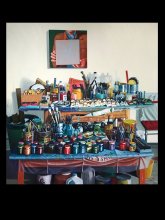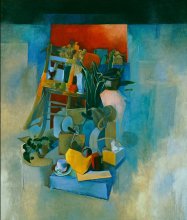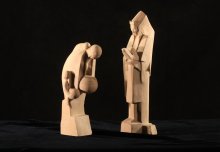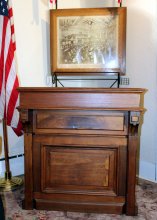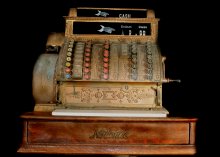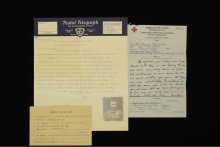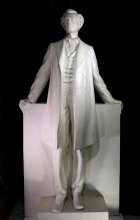Modern Era (1917-present)
The state’s Modern Era has been one of continued growth and change. Following World War I and the nation’s greatest economic collapse, public works projects of the New Deal put people to work on civic projects, such as building roads and infrastructure, and brought history to life by protecting a number of historic places around the state. The Federal Arts Program of the W.P.A. paid artists to create paintings, prints, sculptures, and murals for civic beautification, pride, and capturing the moment. Beginning in 1941, the state’s agricultural and manufacturing sectors and the sacrifices of citizen-soldiers played an important role in making the United States a leader on the world stage.
Artist Ken Holder paints his own sunbathed studio in life-size scale, demystifying his practice and commenting on the mundane materials used to produce his art. Above all the art supplies hangs one of his cropped, self-portrait paintings from a series of similar paintings that he was working on at the time. This large studio painting does not reveal the artist’s face, but it does reveal his world. This is the world of a studio painter in the 1970s, captured with fidelity in living color.
Ted Halkin’s early works were highly-symbolic, id-driven reflections of his influences and love of archetypal imagery. He became associated with a post-war group of Chicago artists known as “The Monster Roster” for their collective expressionistic, existential nod to antiquity such as Cosmo Campoli, Dominic Di Meo, Leon Golub, Seymour Rososfky, and Nancy Spero.
This sculpture is an example of Social Realism, a style of art that emphasized depictions of contemporary life as a means of social or political commentary. The artist, ‘Si’ Gordon, was employed in the sculpture division of the Federal Art Project (1935-43), a Works Project Administration program that employed artists on a monthly stipend. The Federal Art Project established more than 100 community art centers throughout the country, researched and documented American design, commissioned murals and sculptures for public buildings, and sustained some 10,000 artists and craft workers during the Great Depression.
These terracotta sculptures were produced in 1929-1930 by Charles L. Morgan, cast from the original plaster models sculpted by Frank Lloyd Wright. The figures represented Wright’s designs for proposed monumental entry figures to the Community of Nakoma Country Club in Madison, Wisconsin, which were never ultimately completed. These designs were likely the last figurative sculptural works created by Wright, his interest in exploring natural themes and material taking priority in his later designs.
Richard Lawson was serving a sentence for marijuana possession in 1969 when he was assigned to serve as an inmate photographer at the Joliet Stateville Prison. During this time, he discovered a cache of glass plate negatives produced by inmates at about the turn of the century. Years later, when he became a professor at Southern Illinois University, he conserved and put together an exhibition of the images in 1981. So far, more than 100 images have been preserved and printed.
John C. McKenzie (1860-1941) began his career as a lawyer in the small village of Elizabeth in northwestern Illinois. He served in the Illinois House from 1892 to 1896 and in the Illinois Senate from 1900 until 1911. He used this desk until the State ordered new ones for both chambers.
From its opening in 1905, O.M. Bishop called his store "The Busy Big Store," advertising five departments (clothing, shoes, groceries, variety, and dishes) under one roof. On the second floor, the biggest theater in the county at its opening, the Lyric Theater, showed movies from 1916-1931. This space also served as a community meeting house where dances, suppers, vaudeville shows, graduations, and even roller skating took place.
On May 8, 1942, Roland and Lydia Batchelder of Peru, Illinois, received the telegram that all soldiers’ parents dread. It informed them that their son, Walter, had been reported missing in action. Walter was a Marine with the 4th Regiment, deployed to Corregidor in Manila Bay. Almost one year later, his parents learned that Walter had been captured at the Battle of Corregidor and was being held as a prisoner of war in Tokyo.
This plaster study for a larger bronze sculpture was made by the prominent Illinois sculptor, educator, and writer Lorado Taft. The full-scale bronze statue was erected in Urbana, Illinois, in 1926, where it still stands today. The sculpture was a commission made possible through a bequest of a family that had known Lincoln during his circuit lawyer days from 1837-1848.
Born in Toledo, Ohio, in 1926, Carolyn moved to Carbondale, Illinois, in 1949 to teach art at the Allyn Training School at Southern Illinois University. After marrying George Plochmann in 1950, Carolyn became a full-time studio artist, spent her summers in Woodstock, New York, and was represented by the Kennedy Galleries in New York from 1970-2005.
Pages






